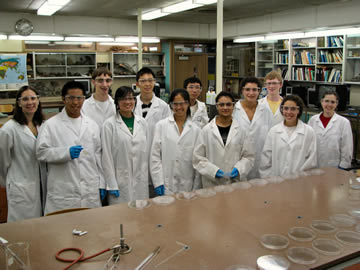 |
New Jersey Governor's School in the Sciences at Drew University |
 |
Drew Links |
|
| Team Projects | |
| NJGSS Home | |
| About NJGSS | |
Related Links |
|
| Drew University | |
2008 Team 3 |
||||||||
THE ANTIMICROBIAL ACTIVITY OF GREEN TEA ( Camellia sinensis ) ON S taphylococcus aureus IN COMBINATION WITH ASCORBIC ACID, ACETIC ACID, AND SODIUM CHLORIDE Timothy Barnum, Steven Castellano, Annie Chen, Neha Jariwala, Andrew Jung, Kelvin Mei, Christina Sedberry, Margaret To, Heather Tynan, Charles Zou Advisor: Mrs. Rachel Sandler |
||||||||
ABSTRACTGreen tea contains polyphenolic catechins that have been demonstrated to effectively inhibit Staphylococcus aureus and related bacteria. This study aimed to determine if home-brewed green tea could inhibit S. aureus through paper disk diffusion and minimum inhibitory concentration experiments. It was hypothesized that green tea brewed for varying periods of time in solutions with ascorbic acid, acetic acid, and sodium chloride would most significantly inhibit S. aureus . The paper disk diffusion test showed that solutions of vinegar and vinegar with green tea produced zones of inhibition. However, the minimum inhibitory concentration test exhibited relatively uniform turbidity between the control and solutions, thus producing inconclusive results. It was determined that green tea did not significantly inhibit S. aureus and that vinegar had the greatest impact on bacterial growth. |
||||||||
|
||||||||
